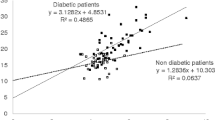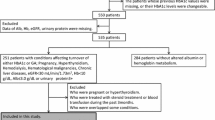Abstract
Background
Since the half-life of red blood cells (RBCs) is shorter in hemodialysis patients, the value of glycated hemoglobin (HbA1c) as a marker of glycemic control in patients with diabetes on hemodialysis has recently been questioned. It is thought that it is not a good marker of mean plasma glucose (MPG) over a 3-month duration. In our current study, we evaluate whether monthly HbA1c values is a better marker of glycemic control than HbA1c every 3 months.
Method
We performed a cross-sectional analysis of a retrospective cohort of 152 patients with diabetes who presented to two hemodialysis units in NYC. Patients had weekly predialysis glucose levels checked over the last 3 months, and HbA1c values were checked every 3 months. Data collection spanned a 6-month time frame from August 2008 to January 2009.
Results
We found no difference in the correlation between HBA1c/mean plasma glucose (MPG) over the last month (MPG1m) and HbA1c/mean plasma glucose (MPG) over the last 3 months (MPG3m; r = 0.57 and r = 0.53, respectively; P = 0.212). Using multivariate analysis, reticulocyte count and weekly erythropoietin dose were found to independently and inversely effect the correlations HbA1c/MPG1m and HbA1c/MPG3m.
Conclusion
The value of HbA1c in hemodialysis for monitoring glycemic control is limited in the setting of a high reticulocyte count (>2%) and a high weekly erythropoietin dose. Checking HbA1c monthly versus every 3 months is not a better approximation of glycemic control in hemodialysis patients.

Similar content being viewed by others
References
Foley RN, Collins AJ (2009) The growing economic burden of diabetic kidney disease. Curr Diab Rep 9:460–465
Warram JH, Manson JE, Krolewski AS (1995) Glycosylated hemoglobin and the risk of retinopathy in insulin-dependent diabetes mellitus. N Engl J Med 332:1305–1306
Townsend RR (1993) The effect of intensive treatment of diabetes on the development and progression of long-term complications in insulin-dependent diabetes mellitus. The Diabetes Control and Complications Trial Research Group. N Engl J Med 329:977–986
Hirszel P, Galen MA, Happe T, Lasrich M (1981) Glycosylated hemoglobin in patients treated by chronic dialysis. Int Urol Nephrol 13:185–191
Freedman D, Dandona P, Fernando O, Moorhead JF (1982) Glycosylated haemoglobin in chronic renal failure and after renal transplantation. J Clin Pathol 35:737–739
Williams ME, Lacson E Jr, Teng M, Ofsthun N, Lazarus JM (2006) Hemodialyzed type I and type II diabetic patients in the US: characteristics, glycemic control, and survival. Kidney Int 70:1503–1509
Inaba M, Okuno S, Kumeda Y, Yamada S, Imanishi Y, Tabata T, Okamura M, Okada S, Yamakawa T, Ishimura E, Nishizawa Y (2007) Glycated albumin is a better glycemic indicator than glycated hemoglobin values in hemodialysis patients with diabetes: effect of anemia and erythropoietin injection. J Am Soc Nephrol 18:896–903
Rohlfing CL, Wiedmeyer HM, Little RR, England JD, Tennill A, Goldstein DE (2002) Defining the relationship between plasma glucose and HbA(1c): analysis of glucose profiles and HbA(1c) in the diabetes control and complications trial. Diabetes Care 25:275–278
Uzu T, Hatta T, Deji N, Izumiya T, Ueda H, Miyazawa I, Kanasaki M, Isshiki K, Nishio T, Arimura T (2009) Target for glycemic control in type 2 diabetic patients on hemodialysis: effects of anemia and erythropoietin injection on hemoglobin A(1c). Ther Apher Dial 13:89–94
Drechsler C, Krane V, Ritz E, Marz W, Wanner C (2009) Glycemic control and cardiovascular events in diabetic hemodialysis patients. Circulation 120:2421–2428
Masanori S, Toshihiko S, Koji H, Hidekazu H, Mitsuharu H, Takanobu A, Takeshi I, Yasuyuki B, Shigefumi S (2004) Orally administered benidipine and manidipine prevent ischemia-reperfusion injury in the rat heart. Circ J 68:241–246
Peacock TP, Shihabi ZK, Bleyer AJ, Dolbare EL, Byers JR, Knovich MA, Calles-Escandon J, Russell GB, Freedman BI (2008) Comparison of glycated albumin and hemoglobin A(1c) levels in diabetic subjects on hemodialysis. Kidney Int 73:1062–1068
Disclosures
All authors have no financial support or conflicts of interest to report.
Author information
Authors and Affiliations
Corresponding author
Rights and permissions
About this article
Cite this article
Israel, E., Geara, A., Maarouf, O. et al. Correlation between glycated hemoglobin and mean plasma glucose in hemodialysis patients. Int Urol Nephrol 43, 1149–1153 (2011). https://doi.org/10.1007/s11255-010-9800-1
Received:
Accepted:
Published:
Issue Date:
DOI: https://doi.org/10.1007/s11255-010-9800-1




